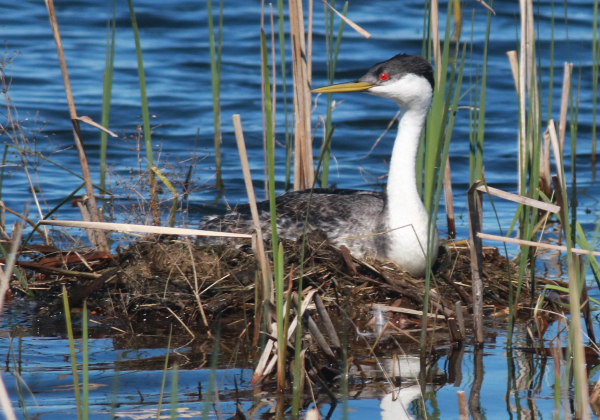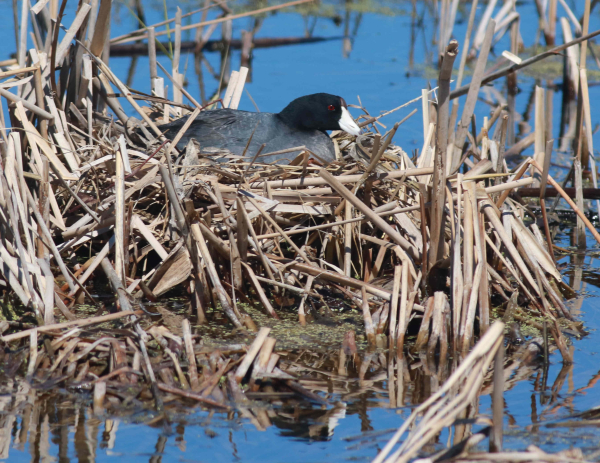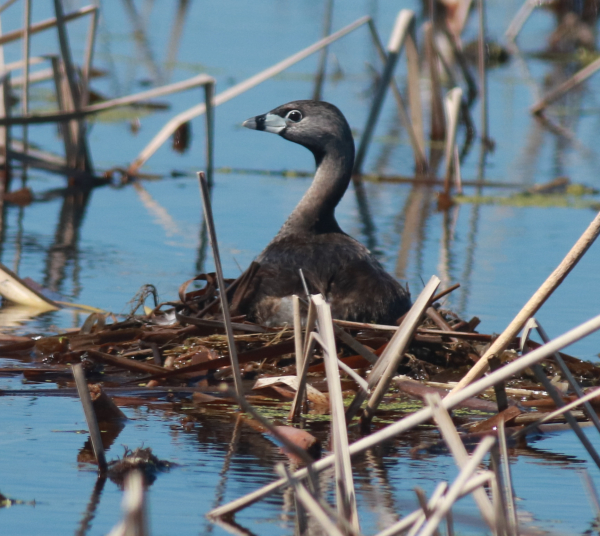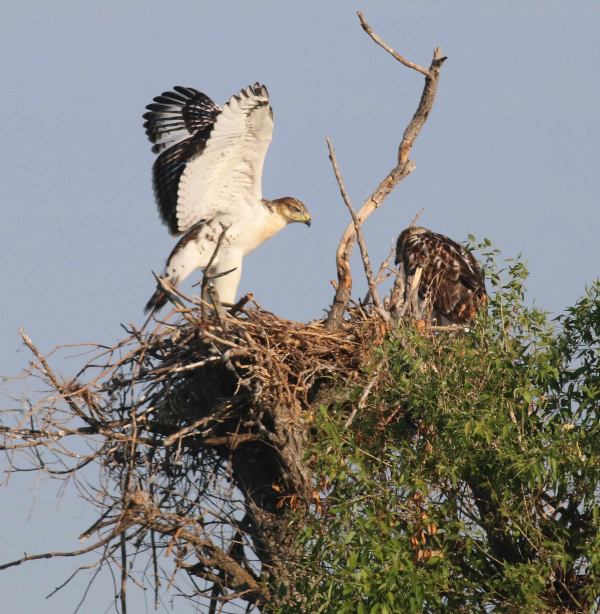The nesting season is exciting for all birders as the annual period of reproduction for all bird species. We birders are aware of the importance of protecting birds during this vulnerable period, when nesting birds and their eggs and nestlings are tied to one location. They must survive predators, wind storms and hail, and even uncertain food availability. Appreciating this, we photographers are especially concerned about any impact we could potentially have on nesting birds. Only when we have a safe opportunity to photograph nesting birds – safe for the birds – does any photo option becomes a brief special chance that we only take with a high level of caution.

A quick snapshot from a considerable distance with a telephoto lens did not disturb the incubating Western Grebe. The photo was also cropped using photo editing software to increase the magnification of the bird, nest, and surroundings.
|
My favorite photo episodes with birds are when I can take my photos and leave the bird without being affected by the interaction. When it comes to photographing nesting birds, that type of experience is imperative. As a biologist I have specialized in conducting research studies of nesting birds for decades, so I have an almost automatic understanding of the importance of observing nesting birds from a distance – using binoculars, a spotting scope, and/or camera with a lens with high magnification while limiting any observation or photo opportunity to a very short period of time – with the understanding that a minute is a long time. We should be able to take a couple documentary photos from a safe distance, then leave the area quietly without affecting the birds’ behavior.
No Stress Success
Last week, I had a good opportunity to document three species of nesting waterbirds that began nest building, egg laying, and incubation. I found all but one nest within two miles of home, close enough to a paved highway that I could safely pull off the side of the road, photograph the incubating birds at select nests for a few seconds, then slowly and quietly drive away. The birds were not alarmed; they were aware, but I offered no more of a concern than any car, truck, or van that passes by periodically, and much less concern than the loud imposing semi-trucks or farm tractors that occasionally drive by.
Birds can tell when there is a potential for danger; if you approach them slowly, indirectly, and with a minimum of sound or quick motion, you can often approach their position from a distance, then utilize the magnification provided by your telephoto or zoom lens to get a “closer” image. One thing you will find is that nesting birds, especially birds that are incubating eggs or brooding nestlings, don’t want to leave their nest, so don’t press them to that point. Keep your distance, take your photos, and leave without disturbing any bird at its nest.

In the case of photographing the incubating American Coot, the apparent lack of interest by the bird makes a less than exciting image, but it documents the long incubation period quite well – incubation is uneventful, until the eggs hatch.
|
Having said that, enjoy the excitement of the moment as a birder when you can see a species’ nest, the materials it’s made of, the surrounding habitat, and all the other information you can glean from the surroundings. Seeing an active bird nest from a distance is an exciting opportunity, and photographing nesting birds may be even more exciting. Sharing the photos you take with others may help them gain a greater appreciation for birds, including the variety of birds and the variety of nesting strategies different species exhibit. But be sure to share how careful you were in the photo process.
To photograph nesting birds appropriately from a technical standpoint, it may mean assessing the setting in advance. Consider the nest position, when the best light will be available, and where there may be an opening in surrounding vegetation for you to get the best angle when taking your photos. That was the case when I was surprised to find a dozen pairs of Western Grebes involved in a flurry of nesting activities – actively nest building in a new nesting colony late Tuesday afternoon. As I took a moment to count the number of nests from a distance and watched some of the activities between neighboring pairs, I could see that a few grebes were already in egg laying or incubating position atop finished nests.
I was also quickly aware that the best light to document the nesting grebes would be during the morning, when the sunlight comes from the east. Therefore, Wednesday morning I pulled off the side of the highway with the closest nest as my point of interest. A Western Grebe was in incubating position there, facing toward the sun. I slowly pulled up to a position where there was a slight opening in the newly emerging plants where I could see the grebe’s neck and head clearly. The grebe was aware of me, but was not disturbed, so I quickly took a few photos as it looked this way and that in the pretty morning light, then restarted my vehicle and slowly drove away.

Because Paul approached the incubating Pied-billed Grebe from behind, it may have showed a bit more interest by raising its head higher, but in a moment it turned around and lowered its head with no further concern.
|
From there, I drove north a short distance to the site where I knew of three American Coot nests on the west side of the highway. I pulled up to two of these nests in a similar cautious fashion, but the incubating coots showed little interest or concern for my positioning, and I took a couple quick photos and slowly pulled away. These coot nests are only ¾ of a mile south of home, and the grebe nesting colony is only 2 miles south, so I’ll enjoy monitoring the progress of these nesting birds during coming weeks.
I had a third opportunity to photograph another nesting waterbird about a half-hour later, when I found an incubating Pied-billed Grebe off the side of a remote gravel road. The incubating bird was aware of my mobile blind (vehicle) as I cautiously approached, but I photographed from a safe distance and let my 400mm telephoto lens do the work. The lens magnifies the bird and nest 11 times, and if necessary, it’s easy to effectively magnify the image more by cropping extraneous parts of the photos using photo editing software, which I did for all the photos I wanted to share with you.
These Wednesday morning examples of photographing nesting birds are probably just the beginning of a series of photos I will take during the course of the nesting periods of each of these species. For these waterbirds – the two species of grebes and the coots – the precocial hatchlings will leave the nest a few hours after hatching. As soon as they hit the water, they will begin swimming, following the adults that will feed and protect them on the water. And it gives me hope that I should have excellent opportunities to photograph small downy grebes riding on the back of adults in a few weeks.
Documenting the Nestling Period
Unlike the precocious hatchlings of these waterbirds, nesting songbirds, birds of prey, and others are tied to their nests longer as they feed and brood their altricial nestlings that spend an extended nestling period within the nest. The nestling period lasts from hatching to fledging, and offers more photo opportunities. Even so, the same levels of caution and concern apply when photographing birds during this nestling phase.

An exercising nestling Ferruginous Hawk prepares for fledging and expanding its range beyond the nest. It’s always fulfilling to see birds act naturally when you photograph them from a distance.
|
One thing I have learned is that each pair of nesting birds is individual in its reaction to a vehicle approach – or a human approach, which is usually more concerning for birds. For instance, I monitor two Ferruginous Hawk nests each year – one located 11 miles south of my office, the other located 24 miles west-northwest of here. The pairs that nest at each of these nests react in opposite ways to my approach.
The south pair is very trusting and has never reacted to my distant approaches aside from an awareness that my vehicle is present. At the other end of the spectrum, the west pair reacted immediately to my vehicle stopping by the side of the highway, with the hawk at the nest taking flight. That’s something that we should all avoid, so I initially reacted to the hawk’s extreme behavior by immediately leaving the area so the bird would return as soon as possible. Since then, I don’t bother the super-wary pair. As for the trusting pair, I may photograph for a moment about once a week after the nestlings become visible above the rim of the nest, when a good photo opportunity presents itself.
Getting to know the birds you photograph is a special aspect of birding, and it not only provides a better understanding of the birds, it raises our awareness of the need to limit our activities and time near nest sites. Bird photography is a remarkable part of birding, and it provides an even greater level of awareness and concern that we try our best not impact the activities of the birds we photograph – or try to photograph – during the nesting season, or any season. Enjoy learning more about the birds you photograph during their remarkable nesting activities.
Article and photos by Paul Konrad
Share your bird photographs and birding experiences at editorstbw2@gmail.com